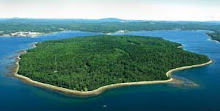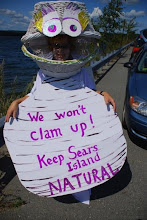 On 8/4/09 at 10:21 AM, PenBayResident wrote: Repeated separate thumbs down will cause comment to be hidden
On 8/4/09 at 10:21 AM, PenBayResident wrote: Repeated separate thumbs down will cause comment to be hidden(1) The laughable Mack Point study only concluded that a mega container port (four berths) couldn't be built. The study did not look at short route movement of containers using a single berth at Mack but Sprague did research that option and the physical characteristics are fine.
(2) The container business has virtually collapsed. See the Economist piece from July 30. Shipping companies are expected to lose $20 billion this year! One of the world's largest container companies spoke of a "gruesome" excess of capacity. The Economist also says that this dismay outlook for container shipping isn't only because of the Great Recession. They claim that industry insiders believe the reallocation of resources and manufacturing during the expansion of globalization has reached capacity and the one-off restructuring is complete. There will not be further expansion of the container trade, even when (or if) the economy gets better. MDOT may want a container port but good luck pursuing that pipe dream.
(3) No one involved in the JUPC has contributed to any kind of rift with so-called "proponents of no development." That rift seems self-imposed by some for unknown reasons. Some "proponents of no development" have attributed positions (for example, that every JUPC member outright supports building a port on Sears Island) that are simply and abosolutely untrue. The record is clear for anyone genuinely interested in the facts. Shouting and wishing otherwise doesn't change the truth.
(4) As of this moment in time, there is no port on Sears Island. It remains to be seen whether or not there ever will be a port there. Meanwhile, FOSI and others are slowly, carefully, respectfully dedicated to protecting the island AND making visitors welcome.
On 8/4/09 at 3:08 PM, PeterTaber wrote: Repeated separate thumbs down will cause comment to be hidden
As one of the more outspoken and visible proponents of no development at Sears Island, I’m unaware of anyone who believes “every” member of the state-sponsored Joint Use Planning Committee (JUPC) “outright supports building a port on Sears Island.” (As long as I’m addressing what is a straw man issue, I’m also unaware of any “shouting.”)
This is what I am aware of:
(1) All the members of JUPC participated in Gov. Baldacci’s underhanded and highly manipulated planning process for the island. This was a process that at the outset actively solicited comment from the general public, then when those comments turned out to be overwhelmingly in favor of total preservation of the island in its present wild state totally ignored them. This was a process that formally recognized that many people had little faith in the honesty of the industrial cheerleaders at the Department of Transportation. As a result, it was arranged that the Department of Conservation would be in charge. This was a process in which it turned out the Department of Conservation was not above conducting secret meetings at its headquarters in Augusta at which the critical language for a consensus agreement was drafted.
(2) The agreement stated on its first page not once but twice that building a container port on Sears Island is “appropriate.” The signers also agreed that building a port was not only appropriate but among the elements that “should be vigorously pursued.” Other language, again drafted in secret in the presence of a select group that apparently could be counted upon not to object, stated that barring a failure “to meet applicable environmental standards,” the signers “would not object to or oppose fulfillment of a cargo/container port on Sears Island.” Specific details of the proposed port that emerged included the clearcutting and leveling of up to a third of this now totally wild island, two (not four) marginal berths extending for half a mile along the island’s western shore, a highway loop for heavy truck traffic encircling some 80 acres of supposedly conserved wild land, and three lines of rail spur a mile and a half long.
(3) All the JUPC members signed that consensus agreement. In fact, it was a sine qua non for appointment to a committee whose basic task was to divide up the island into port and port buffer zones. The port buffer zone was afterwards the subject of a conservation easement that effectively handed over 601 acres of wild island land belonging to the people of Maine to a private nonprofit corporation, Maine Coast Heritage Trust of Brunswick. This “buffer easement” allows for construction of what I like to call EcoWorld, a “green sprawl” education complex across much of the island’s northeastern quadrant that would include up to 10,000 square feet of building footprint for classrooms, meeting halls and rented government offices (the U.S. Fish and Wildlife Service has already expressed interest in relocating its Petit Manan headquarters here). There are also provisions for an amphitheater seating perhaps 400 or 500 people, a wind turbine of unrestricted height, solar panel arrays, battery sheds, kiosks and all the paved access roads and parking lots needed to support such a development.
(4) The reason Gov. Angus King reluctantly and most peevishly abandoned plans for a cargo port on Sears Island in 1996 was because he couldn’t cobble together enough newly conserved land to mitigate for the enormous amount of environmental harm to island wetlands and the waters offshore that construction and the resulting facility would cause. Scientists from three federal natural resource agencies concluded in a joint letter at the time that this was the most destructive project ever proposed for review in New England. The container port now being actively marketed by the Baldacci administration is far more extensive. Early last year, officials at the Federal Highway Administration, who have been following developments closely, commented that the conservation easement granted to Maine Coast Heritage Trust would go far in meeting this previously insurmountable hurdle for mitigation.
No, I don’t for a moment believe the so-called environmental advocates who participated in this farce really want to see a port of any sort on Sears Island. On the other hand, I do believe their timidity and in the case of most of them their career self-interest kept them from speaking out decisively when it really might have counted. The damage is done and building some stairways down to the shore won’t undo it.
I join them in sincerely hoping economic conditions will accomplish what their own lack of backbone in the face of obvious corruption failed to do.
Peter Taber
Publisher
Wild Maine Times
Searsport
On 8/4/09 at 4:36 PM, PenBayResident wrote: Repeated separate thumbs down will cause comment to be hidden
It is my understanding that the Sears Island agreement to which Mr. Taber refers says, "appropriate uses for Mack Point and Sears Island are compatibly managed marine transportation, recreation, education and conservation." Two locations, four uses, zero delineation as to which should go where in this statement about "appropriate uses." It is therefore possible, even likely, that some of those who agreed to this statement believe the transportation uses should be at Mack Point and the other uses at Sears Island.
The agreement, I believe, also says, "It is understood that none of the parties are endorsing in advance any proposal for a marine transportation facility. They will not, however, oppose such a facility for “nonsubstantive” reasons." So what are nonsubstantive and what are substantive reasons to oppose a port? An enviro, even a timid one, would certainly say that wetlands, fish habitat, eel grass beds, vernal pools, scenic vistas and endangered species habitat are all "substantive." Aren't those, or some of those, why the environmental values were so high back in the cargo port controversy? So enviros seem to have retained the right to raise those same issues again, should they so choose.
And isn't it just possible that the "so-called environmental advocates who participated in this farce" anticipated economic conditions working against a port?
One man's lack of backbone just may be another man's well considered strategy.
On 8/4/09 at 7:01 PM, PeterTaber wrote: Repeated separate thumbs down will cause comment to be hidden
Please check out the wording in item 4 on page 4 of the consensus agreement document, PenBayResident. It says: "If any cargo/container port proposal is determined to meet applicable environmental standards, including an alternatives analysis which documents that the need could not be met elsewhere, all parties agree they would not object to or oppose fulfillment of a cargo/container port on Sears Island once such development has satisfied all regulatory requirements." Aside from the strange redundancy, notice there is no and/or phrasing that includes Mack Point.
The alternatives analysis was released in June and, not surprisingly for anyone who has closely followed the DOT's single-minded focus on Sears Island, it rules out Mack Point. That analysis may have indeed been, as you say, "laughable" but those are the conditions the environmental representatives who signed the agreement accepted.
What surprises me is the analysis never considered the most blatant reason why Mack Point won't do for a container port. This must be something the DOT is holding in reserve. Check out the water depths immediately off Mack Point. A typical container ship draws about 44 feet of water and because of the nature of the huge cranes needed to move containers must tie up at a marginal wharf that unlike a finger pier extending into deeper water hugs the shore. You can probably wade across Long Cove at low tide. The amount of dredge spoils that would have to be excavated and then disposed of to make Mack Point viable as a container port would be monumental. By contrast, the waters immediately off the originally planned port site on the west side of Sears Island are relatively deep and would require minimal dredging. Penobscot Bay pilot David Gelinas, who participated in the Sears Island Planning Initiative (he declined to sign the consensus agreement), pointed this out early in the process. I think he might know something. In fact, what really surprises me is that the DOT representatives didn't cynically come out with the argument that because of the enormous amount of dredging necessary at Mack Point the environmentally RESPONSIBLE course would be to rape Sears Island instead!
Leaving these matters aside, the mostly institutional environmental representatives have behaved badly in a number of ways. They have never challenged the Baldacci administration's moronic unwillingness to recognize the economic value of properties like Sears Island in contributing to the ambiance -- to the "branding" if you will -- that has long made this state a most desirable place to vacation in, to retire to, to send down roots in as part of that "creative economy" that Gov. B and his sycophants pay only lip service to. This is Maine's real business and the source of its real wealth.
Sadly, because this oldest, healthiest, most sustainable and overwhelmingly most important portion of Maine's economy mostly involves small business operators, the governor and his friends don't pay much attention. A railroad bankrupted by the declining fortunes of the woods products industry and potato farming is what he is most solicitous about. A group of wealthy speculators in Chicago with more pipedreams to sell than substance are his more important constituents. We saw that during the SIPI proceedings when the general public, which mostly advocated for saving this rare and precious island from destruction, found itself marginalized and ignored. But corporate executives like Robert Grindrod, CEO of the Maine, Montreal and Atlantic Railway, had honored seats at the table. DOT Commissioner David Cole usually sat next to Grindrod. If these state officials like the governor aren't corruptly in the pocket of big business, then they're amazingly stupid. As you have already made the case ably, PenBayResident, the economics don't for a moment support construction of a $200 million container port. The economists on the state payroll should be transferred to the DOT to see if any of them are competent enough to operate a plow truck.
The environmental representatives also didn't challenge an enormous amount of dishonesty and manipulation on the part of state officials. I suppose many of them were charmed to have so much attention paid to them. I find it unforgivable that they not only raised no objection to the secret meetings at DOC headquarters in December 2006, they actually colluded with the state in this dishonesty. As a newspaper reporter I crashed such a meeting. It was technically a public meeting after all. Nobody bothered to let anyone but a select group know, that's all. I had the strange experience of having Karin Tilberg, then a Conservation Department assistant commissioner, now a special advisor to the governor, plead with me to leave. I refused. John Melrose, a former DOT commissioner turned transportation industry lobbyist, didn't object. "I have nothing to hide," he said. I respected his candor. He was honestly upfront about what he wanted. The "environmentalists" were another story. They silently got up and filed out into the hall to confer. When it became obvious I wasn't going anywhere they all packed up and went home.
Strategy is one thing. Playing fast and loose with the truth is another. So is being two-faced in one's dealings. At one point, Scott Dickerson, executive director of Coastal Mountains Land Trust in Rockport, circulated an email among his colleagues essentially suggesting they could always go back on their pledge to support the consensus agreement if it didn't work out to their liking. In another email, Ken Cline, a Maine Sierra (Hiking) Club official and environmental law professor at College of the Atlantic in Bar Harbor, wrote something similar, saying that once the "environmentalists" secured two thirds of the island in a conservation easement they could move forward in clear violation of at the very least the spirit of their consensus agreement pledge to secure the remainder.
People like Dickerson, Cline, Sierra Club official representative Joan Saxe of Freeport and self-proclaimed Earth Firster and Maine Independent Green Party figure Jim Freeman of Verona (a secret pipeline of snitchery to the Governor's Office, it has been recently revealed) have not only done enormous damage to the cause of saving Sears Island from environmental destruction, they've also helped bring down discredit down upon the various perhaps otherwise worthy organizations and institutions they represent. It's really all very sad.
Peter Taber
Publisher
Wild Maine Times
Searsport





